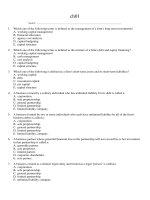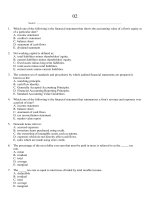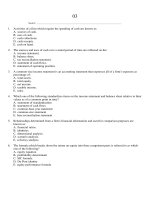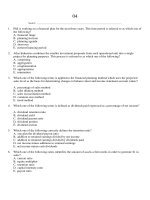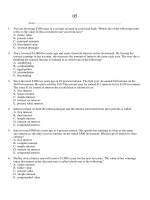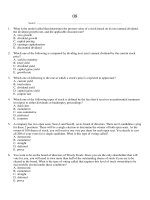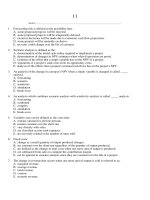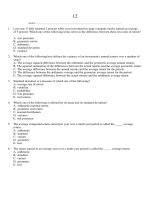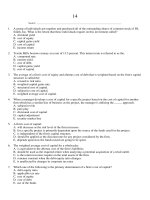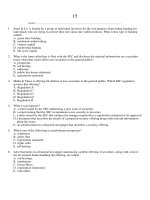Test bank fundamentals of corporate finance 9th edition chap004
Bạn đang xem bản rút gọn của tài liệu. Xem và tải ngay bản đầy đủ của tài liệu tại đây (643.28 KB, 95 trang )
Chapter 04 - Long-Term Financial Planning and Growth
Chapter 04
Long-Term Financial Planning and Growth
Multiple Choice Questions
1. Phil is working on a financial plan for the next three years. This time period is referred to as
which one of the following?
A. financial range
B. planning horizon
C. planning agenda
D. short-run
E. current financing period
2. Atlas Industries combines the smaller investment proposals from each operational unit into
a single project for planning purposes. This process is referred to as which one of the
following?
A. conjoining
B. aggregation
C. conglomeration
D. appropriation
E. summation
3. Which one of the following terms is applied to the financial planning method which uses
the projected sales level as the basis for determining changes in balance sheet and income
statement account values?
A. percentage of sales method
B. sales dilution method
C. sales reconciliation method
D. common-size method
E. trend method
4-1
Chapter 04 - Long-Term Financial Planning and Growth
4. Which one of the following terms is defined as dividends paid expressed as a percentage of
net income?
A. dividend retention ratio
B. dividend yield
C. dividend payout ratio
D. dividend portion
E. dividend section
5. Which one of the following correctly defines the retention ratio?
A. one plus the dividend payout ratio
B. addition to retained earnings divided by net income
C. addition to retained earnings divided by dividends paid
D. net income minus additions to retained earnings
E. net income minus cash dividends
6. Which one of the following ratios identifies the amount of assets a firm needs in order to
generate $1 in sales?
A. current ratio
B. equity multiplier
C. retention ratio
D. capital intensity ratio
E. payout ratio
7. The internal growth rate of a firm is best described as the:
A. minimum growth rate achievable assuming a 100 percent retention ratio.
B. minimum growth rate achievable if the firm maintains a constant equity multiplier.
C. maximum growth rate achievable excluding external financing of any kind.
D. maximum growth rate achievable excluding any external equity financing while
maintaining a constant debt-equity ratio.
E. maximum growth rate achievable with unlimited debt financing.
4-2
Chapter 04 - Long-Term Financial Planning and Growth
8. The sustainable growth rate of a firm is best described as the:
A. minimum growth rate achievable assuming a 100 percent retention ratio.
B. minimum growth rate achievable if the firm maintains a constant equity multiplier.
C. maximum growth rate achievable excluding external financing of any kind.
D. maximum growth rate achievable excluding any external equity financing while
maintaining a constant debt-equity ratio.
E. maximum growth rate achievable with unlimited debt financing.
9. You are developing a financial plan for a corporation. Which of the following questions
will be considered as you develop this plan?
I. How much net working capital will be needed?
II. Will additional fixed assets be required?
III. Will dividends be paid to shareholders?
IV. How much new debt must be obtained?
A. I and IV only
B. II and III only
C. I, III, and IV only
D. II, III, and IV only
E. I, II, III, and IV
10. Financial planning:
A. focuses solely on the short-term outlook for a firm.
B. is a process that firms employ only when major changes to a firm's operations are
anticipated.
C. is a process that firms undergo once every five years.
D. considers multiple options and scenarios for the next two to five years.
E. provides minimal benefits for firms that are highly responsive to economic changes.
4-3
Chapter 04 - Long-Term Financial Planning and Growth
11. Financial planning accomplishes which of the following for a firm?
I. determination of asset requirements
II. development of plans to contend with unexpected events
III. establishment of priorities
IV. analysis of funding options
A. I and III only
B. II and IV only
C. I, III, and IV only
D. I, II, and III only
E. I, II, III, and IV
12. Which of the following questions are appropriate to address during the financial planning
process?
I. Should the firm merge with a competitor?
II. Should additional shares of stock be sold?
III. Should a particular division be sold?
IV. Should a new product be introduced?
A. I, II, and III only
B. I, II, and IV only
C. I, III, and IV only
D. II, III, and IV only
E. I, II, III, and IV
13. Which one of the following statements concerning financial planning for a firm is
correct?
A. Financial planning for fixed assets is done on a segregated basis within each division.
B. Financial plans often contain alternative options based on economic developments.
C. Financial plans frequently contain conflicting goals.
D. Financial plans assume that firms obtain no additional external financing.
E. The financial planning process is based on a single set of economic assumptions.
4-4
Chapter 04 - Long-Term Financial Planning and Growth
14. You are getting ready to prepare pro forma statements for your business. Which one of the
following are you most apt to estimate first as you begin this process?
A. fixed assets
B. current expenses
C. sales forecast
D. projected net income
E. external financing need
15. Which one of the following statements is correct?
A. Pro forma statements must assume that no new equity is issued.
B. Pro forma statements are projections, not guarantees.
C. Pro forma statements are limited to a balance sheet and income statement.
D. Pro forma financial statements must assume that no dividends will be paid.
E. Net working capital needs are excluded from pro forma computations.
16. When utilizing the percentage of sales approach, managers:
I. estimate company sales based on a desired level of net income and the current profit
margin.
II. consider only those assets that vary directly with sales.
III. consider the current production capacity level.
IV. can project both net income and net cash flows.
A. I and II only
B. II and III only
C. III and IV only
D. I, III, and IV only
E. II, III, and IV only
17. Which one of the following is correct in relation to pro forma statements?
A. Fixed assets must increase if sales are projected to increase.
B. Net working capital is affected only when a firm's sales are expected to exceed the firm's
current production capacity.
C. The addition to retained earnings is equal to net income plus dividends paid.
D. Long-term debt varies directly with sales when a firm is currently operating at maximum
capacity.
E. Inventory changes are directly proportional to sales changes.
4-5
Chapter 04 - Long-Term Financial Planning and Growth
18. When constructing a pro forma statement, net working capital generally:
A. remains fixed.
B. varies only if the firm is currently producing at full capacity.
C. varies only if the firm maintains a fixed debt-equity ratio.
D. varies only if the firm is producing at less than full capacity.
E. varies proportionally with sales.
19. A pro forma statement indicates that both sales and fixed assets are projected to increase
by 7 percent over their current levels. Given this, you can safely assume that the firm:
A. is projected to grow at the internal rate of growth.
B. is projected to grow at the sustainable rate of growth.
C. currently has excess capacity.
D. is currently operating at full capacity.
E. retains all of its net income.
20. A firm is currently operating at full capacity. Net working capital, costs, and all assets
vary directly with sales. The firm does not wish to obtain any additional equity financing. The
dividend payout ratio is constant at 40 percent. If the firm has a positive external financing
need, that need will be met by:
A. accounts payable.
B. long-term debt.
C. fixed assets.
D. retained earnings.
E. common stock.
21. Which one of the following policies most directly affects the projection of the retained
earnings balance to be used on a pro forma statement?
A. net working capital policy
B. capital structure policy
C. dividend policy
D. capital budgeting policy
E. capacity utilization policy
4-6
Chapter 04 - Long-Term Financial Planning and Growth
22. You are comparing the current income statement of a firm to the pro forma income
statement for next year. The pro forma is based on a four percent increase in sales. The firm is
currently operating at 85 percent of capacity. Net working capital and all costs vary directly
with sales. The tax rate and the dividend payout ratio are fixed. Given this information, which
one of the following statements must be true?
A. The projected net income is equal to the current year's net income.
B. The tax rate will increase at the same rate as sales.
C. Retained earnings will increase by four percent over its current level.
D. Total assets will increase by less than four percent.
E. Total liabilities and owners' equity will increase by four percent.
23. A firm is operating at 90 percent of capacity. This information is primarily needed to
project which one of the following account values when compiling pro forma statements?
A. sales
B. costs of goods sold
C. accounts receivable
D. fixed assets
E. long-term debt
24. Which one of the following capital intensity ratios indicates the largest need for fixed
assets per dollar of sales?
A. 0.70
B. 0.86
C. 1.00
D. 1.06
E. 1.15
4-7
Chapter 04 - Long-Term Financial Planning and Growth
25. Which of the following are needed to determine the amount of fixed assets required to
support each dollar of sales?
I. current amount of fixed assets
II. current sales
III. current level of operating capacity
IV. projected growth rate of sales
A. I and III only
B. II and IV only
C. I, II, and III only
D. II, III, and IV only
E. I, II, III, and IV
26. The plowback ratio is:
A. equal to net income divided by the change in total equity.
B. the percentage of net income available to the firm to fund future growth.
C. equal to one minus the retention ratio.
D. the change in retained earnings divided by the dividends paid.
E. the dollar increase in net income divided by the dollar increase in sales.
27. A firm's net working capital and all of its expenses vary directly with sales. The firm is
operating currently at 96 percent of capacity. The firm wants no additional external financing
of any kind. Which one of the following statements related to the firm's pro forma statements
for next year must be correct?
A. Total liabilities will remain constant at this year's value.
B. The maximum rate of sales increase is 4 percent.
C. The firm cannot exceed its internal rate of growth.
D. The projected owners' equity will equal this year's ending equity balance.
E. Fixed assets must remain constant at the current level.
28. Which one of the following will increase the maximum rate of growth a corporation can
achieve?
A. avoidance of external equity financing
B. increase in corporate tax rates
C. reduction in the retention ratio
D. decrease in the dividend payout ratio
E. decrease in sales given a positive profit margin
4-8
Chapter 04 - Long-Term Financial Planning and Growth
29. Martin Aerospace is currently operating at full capacity based on its current level of assets.
Sales are expected to increase by 4.5 percent next year, which is the firm's internal rate of
growth. Net working capital and operating costs are expected to increase directly with sales.
The interest expense will remain constant at its current level. The tax rate and the dividend
payout ratio will be held constant. Current and projected net income is positive. Which one of
the following statements is correct regarding the pro forma statement for next year?
A. The pro forma profit margin is equal to the current profit margin.
B. Retained earnings will increase at the same rate as sales.
C. Total assets will increase at the same rate as sales.
D. Long-term debt will increase in direct relation to sales.
E. Owners' equity will remain constant.
30. A firm's external financing need is financed by which of the following?
A. retained earnings
B. net working capital and retained earnings
C. net income and retained earnings
D. debt or equity
E. owners' equity, including retained earnings
31. Sales can often increase without increasing which one of the following?
A. accounts receivable
B. cost of goods sold
C. accounts payable
D. fixed assets
E. inventory
32. Blasco Industries is currently at full-capacity sales. Which one of the following is limiting
sales to this level?
A. net working capital
B. long-term debt
C. inventory
D. fixed assets
E. debt-equity ratio
4-9
Chapter 04 - Long-Term Financial Planning and Growth
33. All else constant, which one of the following will increase the internal rate of growth?
A. decrease in the retention ratio
B. decrease in net income
C. increase in the dividend payout ratio
D. decrease in total assets
E. increase in costs of goods sold
34. The external financing need:
A. will limit growth if unfunded.
B. is unaffected by the dividend payout ratio.
C. must be funded by long-term debt.
D. ignores any changes in retained earnings.
E. considers only the required increase in fixed assets.
35. Which one of the following will cause the sustainable growth rate to equal to internal
growth rate?
A. dividend payout ratio greater than 1.0
B. debt-equity ratio of 1.0
C. retention ratio between 0.0 and 1.0
D. equity multiplier of 1.0
E. zero dividend payments
36. The sustainable growth rate:
A. assumes there is no external financing of any kind.
B. assumes no additional long-term debt is available.
C. assumes the debt-equity ratio is constant.
D. assumes the debt-equity ratio is 1.0.
E. assumes all income is retained by the firm.
4-10
Chapter 04 - Long-Term Financial Planning and Growth
37. If a firm equates its pro forma sales growth to the rate of sustainable growth, and has
positive net income and excess capacity, then the:
A. maximum capacity level will have to increase at the same rate as sales growth.
B. total assets will have to increase at the same rate as sales growth.
C. debt-equity ratio will increase.
D. retained earnings will increase.
E. number of common shares outstanding will increase.
38. Sal's Pizza has a dividend payout ratio of 10 percent. The firm does not want to issue
additional equity shares but does want to maintain its current debt-equity ratio and its current
dividend policy. The firm is profitable. Which one of the following defines the maximum rate
at which this firm can grow?
A. internal growth rate × (1 - 0.10)
B. sustainable growth rate × (1 - 0.10)
C. internal growth rate
D. sustainable growth rate
E. zero percent
39. Which of the following can affect a firm's sustainable rate of growth?
I. capital intensity ratio
II. profit margin
III. dividend policy
IV. debt-equity ratio
A. III only
B. I and III only
C. II, III, and IV only
D. I, II, and IV only
E. I, II, III, and IV
40. Financial plans generally tend to ignore which one of the following?
A. dividend policy
B. manager's goals and objectives
C. risks associated with cash flows
D. operating capacity levels
E. capital structure policy
4-11
Chapter 04 - Long-Term Financial Planning and Growth
41. The financial planning process tends to place the least emphasis on which one of the
following?
A. growth limitations
B. capacity utilization
C. market value of a firm
D. capital structure of a firm
E. dividend policy
42. The financial planning process:
I. involves internal negotiations among divisions.
II. quantifies senior manager's goals.
III. considers only internal factors.
IV. reconciles company activities across divisions.
A. III and IV only
B. II and III only
C. I, II, and IV only
D. II, III, and IV only
E. I, II, III, and IV
43. A Procrustes approach to financial planning is based on:
A. a policy of producing a financial plan once every five years.
B. developing a plan around the goals of senior managers.
C. a proactive approach to the economic outlook.
D. a flexible capital budget.
E. a flexible capital structure.
44. Fresno Salads has current sales of $4,900 and a profit margin of 6.5 percent. The firm
estimates that sales will increase by 5 percent next year and that all costs will vary in direct
relationship to sales. What is the pro forma net income?
A. $303.33
B. $327.18
C. $334.43
D. $338.70
E. $341.10
4-12
Chapter 04 - Long-Term Financial Planning and Growth
45. Wagner Industrial Motors, which is currently operating at full capacity, has sales of
$29,000, current assets of $1,600, current liabilities of $1,200, net fixed assets of $27,500, and
a 5 percent profit margin. The firm has no long-term debt and does not plan on acquiring any.
The firm does not pay any dividends. Sales are expected to increase by 4.5 percent next year.
If all assets, short-term liabilities, and costs vary directly with sales, how much additional
equity financing is required for next year?
A. -$259.75
B. -$201.19
C. $967.30
D. $1,099.08
E. $1,515.25
46. The Cookie Shoppe expects sales of $437,500 next year. The profit margin is 4.8 percent
and the firm has a 30 percent dividend payout ratio. What is the projected increase in retained
earnings?
A. $14,700
B. $17,500
C. $18,300
D. $20,600
E. $21,000
47. Gladsden Refinishers currently has $21,900 in sales and is operating at 45 percent of the
firm's capacity. What is the full capacity level of sales?
A. $31,755
B. $36,250
C. $48,667
D. $51,333
E. $54,500
48. The Corner Store has $219,000 of sales and $187,000 of total assets. The firm is operating
at 87 percent of capacity. What is the capital intensity ratio at full capacity?
A. 0.62
B. 0.68
C. 0.74
D. 1.35
E. 1.47
4-13
Chapter 04 - Long-Term Financial Planning and Growth
49. Miller Bros. Hardware is operating at full capacity with a sales level of $689,700 and
fixed assets of $468,000. The profit margin is 7 percent. What is the required addition to fixed
assets if sales are to increase by 10 percent?
A. $3,276
B. $4,680
C. $28,400
D. $32,760
E. $46,800
50. Designer's Outlet has a capital intensity ratio of 0.87 at full capacity. Currently, total assets
are $48,900 and current sales are $52,300. At what level of capacity is the firm currently
operating?
A. 89 percent
B. 91 percent
C. 93 percent
D. 96 percent
E. 98 percent
51. Monika's Dinor is operating at 94 percent of its fixed asset capacity and has current sales
of $611,000. How much can the firm grow before any new fixed assets are needed?
A. 4.99 percent
B. 5.78 percent
C. 6.02 percent
D. 6.38 percent
E. 6.79 percent
52. Stop and Go has a 4.5 percent profit margin and a 15 percent dividend payout ratio. The
total asset turnover is 1.6 and the debt-equity ratio is 0.60. What is the sustainable rate of
growth?
A. 9.13 percent
B. 9.54 percent
C. 9.89 percent
D. 10.26 percent
E. 10.85 percent
4-14
Chapter 04 - Long-Term Financial Planning and Growth
53. R. N. C., Inc. desires a sustainable growth rate of 4.5 percent while maintaining a 40
percent dividend payout ratio and a 6 percent profit margin. The company has a capital
intensity ratio of 1.23. What equity multiplier is required to achieve the company's desired
rate of growth?
A. 1.33
B. 1.38
C. 1.42
D. 1.47
E. 1.53
54. A firm has a retention ratio of 45 percent and a sustainable growth rate of 6.2 percent. The
capital intensity ratio is 1.2 and the debt-equity ratio is 0.64. What is the profit margin?
A. 6.28 percent
B. 7.67 percent
C. 9.47 percent
D. 12.38 percent
E. 14.63 percent
55. Frasier Cabinets wants to maintain a growth rate of 5 percent without incurring any
additional equity financing. The firm maintains a constant debt-equity ratio of .0.55, a total
asset turnover ratio of 1.30, and a profit margin of 9.0 percent. What must the dividend payout
ratio be?
A. 26.26 percent
B. 38.87 percent
C. 49.29 percent
D. 61.13 percent
E. 73.74 percent
4-15
Chapter 04 - Long-Term Financial Planning and Growth
56. Cross Town Express has sales of $132,000, net income of $12,600, total assets of $98,000,
and total equity of $45,000. The firm paid $7,560 in dividends and maintains a constant
dividend payout ratio. Currently, the firm is operating at full capacity. All costs and assets
vary directly with sales. The firm does not want to obtain any additional external equity. At
the sustainable rate of growth, how much new total debt must the firm acquire?
A. $0
B. $4,311
C. $5,989
D. $6,207
E. $6,685
57. The Two Sisters has a 9 percent return on assets and a 75 percent retention ratio. What is
the internal growth rate?
A. 6.50 percent
B. 6.75 percent
C. 6.97 percent
D. 7.24 percent
E. 7.38 percent
58. The Dog House has net income of $3,450 and total equity of $8,600. The debt-equity ratio
is 0.60 and the payout ratio is 20 percent. What is the internal growth rate?
A. 14.47 percent
B. 17.78 percent
C. 25.09 percent
D. 29.40 percent
E. 33.33 percent
4-16
Chapter 04 - Long-Term Financial Planning and Growth
59. What is Major Manuscripts, Inc.'s retention ratio?
A. 33 percent
B. 40 percent
C. 50 percent
D. 60 percent
E. 67 percent
4-17
Chapter 04 - Long-Term Financial Planning and Growth
60. Major Manuscripts, Inc. does not want to incur any additional external financing. The
dividend payout ratio is constant. What is the firm's maximum rate of growth?
A. 7.44 percent
B. 7.78 percent
C. 9.26 percent
D. 9.75 percent
E. 10.90 percent
61. If Major Manuscripts, Inc. decides to maintain a constant debt-equity ratio, what rate of
growth can it maintain assuming that no additional external equity financing is available.
A. 10.23 percent
B. 10.49 percent
C. 10.90 percent
D. 11.27 percent
E. 11.65 percent
62. Major Manuscripts, Inc. is currently operating at maximum capacity. All costs, assets, and
current liabilities vary directly with sales. The tax rate and the dividend payout ratio will
remain constant. How much additional debt is required if no new equity is raised and sales are
projected to increase by 8 percent?
A. -$157
B. -$68
C. $241
D. $348
E. $367
63. Major Manuscripts, Inc. is currently operating at 85 percent of capacity. All costs and net
working capital vary directly with sales. The tax rate, the profit margin, and the dividend
payout ratio will remain constant. How much additional debt is required if no new equity is
raised and sales are projected to increase by 15 percent?
A. -$810
B. -$756
C. -$642
D. $244
E. $358
4-18
Chapter 04 - Long-Term Financial Planning and Growth
64. Assume the profit margin and the payout ratio of Major Manuscripts, Inc. are constant. If
sales increase by 6 percent, what is the pro forma retained earnings?
A. $5,220.18
B. $5,721.42
C. $6,021.56
D. $6,648.42
E. $7,028.56
65. Assume that Major Manuscripts, Inc. is currently operating at 95 percent of capacity and
that sales are projected to increase to $20,000. What is the projected addition to fixed assets?
A. $0
B. $1,493
C. $1,529
D. $1,546
E. $1,588
4-19
Chapter 04 - Long-Term Financial Planning and Growth
66. All of Fake Stone's costs and net working capital vary directly with sales. Sales are
projected to increase by 3.5 percent. What is the pro forma accounts receivable balance for
next year?
A. $1,659.80
B. $1,661.84
C. $1,780.20
D. $1,787.80
E. $1,800.46
4-20
Chapter 04 - Long-Term Financial Planning and Growth
67. The profit margin, the debt-equity ratio, and the dividend payout ratio for Fake Stone, Inc.
are constant. Sales are expected to increase by $1,062 next year. What is the projected
addition to retained earnings for next year?
A. $92.34
B. $188.55
C. $1,909.16
D. $2,144.34
E. $2,386.08
68. Assume that Fake Stone, Inc. is operating at full capacity. Also assume that all costs, net
working capital, and fixed assets vary directly with sales. The debt-equity ratio and the
dividend payout ratio are constant. What is the pro forma net fixed asset value for next year if
sales are projected to increase by 7.5 percent?
A. $19,800
B. $21,070
C. $23,600
D. $24,240
E. $26,810
69. Assume that Fake Stone, Inc. is operating at 88 percent of capacity. All costs and net
working capital vary directly with sales. What is the amount of the pro forma net fixed assets
for next year if sales are projected to increase by 13 percent?
A. $19,600
B. $20,406
C. $21,500
D. $21,667
E. $22,148
70. Assume that Fake Stone, Inc. is operating at full capacity. Also assume that assets, costs,
and current liabilities vary directly with sales. The dividend payout ratio is constant. What is
the external financing need if sales increase by 12 percent?
A. -$318.09
B. -$268.49
C. $103.13
D. $350.40
E. $460.56
4-21
Chapter 04 - Long-Term Financial Planning and Growth
71. Fake Stone, Inc. is projecting sales to decrease by 4 percent next year while the profit
margin remains constant. The firm wants to increase the dividend payout ratio by 2 percent.
What is the projected increase in retained earnings for next year?
A. $1,711.15
B. $1,898.67
C. $1,943.65
D. $1,969.92
E. $2,105.63
72. What is the internal growth rate of Fake Stone, Inc. assuming the payout ratio remains
constant?
A. 5.20 percent
B. 5.55 percent
C. 7.36 percent
D. 7.49 percent
E. 8.77 percent
73. What are the pro forma retained earnings for next year if Fake Stone, Inc. grows at a rate
of 2.5 percent and both the profit margin and the dividend payout ratio remain constant?
A. $4,946.90
B. $5,023.10
C. $5,592.20
D. $5,920.67
E. $6,293.30
74. Assume that net working capital and all of the costs of Fake Stone, Inc. increase directly
with sales. Also assume that the tax rate and the dividend payout ratio are constant. The firm
is currently operating at full capacity. What is the external financing need if sales increase by
4 percent?
A. -$1,214.48
B. -$804.15
C. -$397.19
D. $201.16
E. $525.38
4-22
Chapter 04 - Long-Term Financial Planning and Growth
75. Hungry Howie's is currently operating at 78 percent of capacity. What is the full-capacity
level of sales?
A. $21,106.00
B. $21,580.62
C. $22,179.49
D. $24,506.17
E. $25,301.91
4-23
Chapter 04 - Long-Term Financial Planning and Growth
76. Hungry Howie's is currently operating at 82 percent of capacity. What is the total asset
turnover ratio at full capacity?
A. .68
B. .78
C. .95
D. 1.29
E. 1.46
77. Hungry Howie's is currently operating at 96 percent of capacity. The profit margin and the
dividend payout ratio are projected to remain constant. Sales are projected to increase by 3
percent next year. What is the projected addition to retained earnings for next year?
A. $1,309.19
B. $1,421.40
C. $1,884.90
D. $2,667.78
E. $3,001.40
78. Hungry Howie's is currently operating at full capacity. The profit margin and the dividend
payout ratio are held constant. Net working capital and fixed assets vary directly with sales.
Sales are projected to increase by 11 percent. What is the external financing needed?
A. -$196.50
B. -$148.00
C. -$97.20
D. -$14.50
E. $26.80
79. Hungry Howie's maintains a constant payout ratio. The firm is currently operating at full
capacity. What is the maximum rate at which the firm can grow without acquiring any
additional external financing?
A. 9.74 percent
B. 10.52 percent
C. 11.06 percent
D. 11.58 percent
E. 12.23 percent
4-24
Chapter 04 - Long-Term Financial Planning and Growth
80. Hungry Howie's is currently operating at 94 percent of capacity. What is the required
increase in fixed assets if sales are projected to increase by 14 percent?
A. $0
B. $511
C. $633
D. $708
E. $777
Essay Questions
81. Why do financial managers need to understand the implications of both the internal and
the sustainable rates of growth?
82. Identify the four primary determinants of a firm's growth and explain how each factor
could either add to or limit the growth potential of a firm.
83. A) What are the assumptions that underlie the internal growth rate and B) what are the
implications of this rate?
4-25
